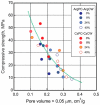Complex Characterization and Behavior of Waste Fired Brick Powder-Portland Cement System
- PMID: 31117225
- PMCID: PMC6566243
- DOI: 10.3390/ma12101650
Complex Characterization and Behavior of Waste Fired Brick Powder-Portland Cement System
Abstract
Two waste fired brick powders coming from brick factories located in Argentine and Czech Republic were examined as alternative mineral admixtures for the production of blended cements. In pastes composition, local Portland cements (Argentine and Czech) were substituted with 8-40%, by mass, with powdered ceramic waste. For the ceramic waste-Portland cement system, workability, the heat released, pozzolanity, specific density, compressive strength, hydrated phases, porosity, and pore size distribution were tested. The relevance of the dilution effect, filler effect, and pozzolanic activity was analyzed to describe the general behavior of the pozzolan/cement system. The properties and performance of cement blends made with finely ground brick powder depended on the composition of ceramic waste and its reactivity, the plain cement used, and the replacement level. Results showed that the initial mini-slump was not affected by a low ceramic waste replacement (8% and 16%), and then it was decreased with an increase in the ceramic waste content. Brick powder behaved as a filler at early ages, but when the hydration proceeded, its pozzolanic activity consumed partially the calcium hydroxide and promoted the formation of hydrated calcium aluminates depending on the age and present carbonates. Finally, blended cements with fired brick powder had low compressive strength at early ages but comparable strength-class at later age.
Keywords: analysis of hydrated products; heat of hydration; physical and chemical parameters; pozzolan; red ceramic waste.
Conflict of interest statement
The authors declare no conflict of interest.
Figures










References
-
- Uddin F., Shaikh A., Nguyen H.L. Properties of concrete containing recycled construction and demolition wastes as coarse aggregates. J. Sust. Cem.-Based Mater. 2013;2:204–217. doi: 10.1080/21650373.2013.833861. - DOI
-
- Kou S.C., Poon S.C. Effects of different kinds of recycled fine aggregate on properties of rendering mortar. J. Sust. Cem.-Based Mater. 2013;2:43–57. doi: 10.1080/21650373.2013.766400. - DOI
-
- Ben Said S.E., Khay S.E., Louilizi A. Experimental investigation of PCC incorporating RAP. Int. J. Concr. Struct. Mater. 2018;12 doi: 10.1186/s40069-018-0227-x. - DOI
-
- Akhtar A., Sarmah A.K. Construction and demolition waste generation and properties of recycled aggregate concrete: A global perspective. J. Clean. Prod. 2018;186:262–281. doi: 10.1016/j.jclepro.2018.03.085. - DOI
Grants and funding
LinkOut - more resources
Full Text Sources

